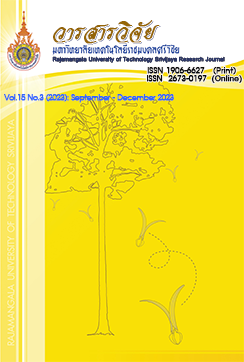Effect of Pectinase Enzyme and Extraction Temperature on Anthocyanins Content from Black Plum (Syzygium cumini Skeels)
Keywords:
Anthocyanins, Pectinase enzyme, Black plum (Syzygium cumini Skeels)Abstract
The objective of this research was to study the effect of pectinase enzyme and extraction temperature on anthocyanins content from black plum (Syzygium cumini Skeels) using the 0.05-0.5% by volume of enzyme concentration and three levels of extraction temperature: room temperature (32-35 oC), 50 and 60 oC, compared with traditional maceration (non-enzymatic). The results showed that the extraction efficiency depended on enzyme concentration and temperature. Total anthocyanin as cyanidin-3-glucoside rose when the enzyme concentration and extraction temperature increased. The extraction using 0.2% of pectinase at 50 oC yielded the highest anthocyanin content (11.76±0.012 mg Cyd-3-glu/g), 39-folds higher than that of non-enzymatic maceration at the same temperature (p < 0.05). The extraction efficiency decreased as the temperature increased because of the enzyme inactivation and anthocyanin decomposition at high temperature. When the concentration of pectinase was over 0.2% and temperature was over 50 oC, anthocyanin contents decreased. In addition, at higher temperature total phenolic content increased but DPPH antioxidant capacity decreased significantly (p < 0.05). In conclusion, pectinase-assisted extraction at the appropriate conditions provided higher concentration of anthocyanins for black plum extraction. It is possible to be applied in extracted black plum juice with higher anthocyanins.
References
Chia, L.S., Kong, J.M., Goh, N.K., Chia, T.F. and Brouillard, R. 2008. Analysis and biological activities of anthocyanins. Phytochemistry 64: 923-933.
Demir, N., Acar, J., Sarıoğlu, K. and Mutlu, M. 2001. The use of commercial pectinase in fruit juice industry part 3: immobilized pectinase for mash treatment. Journal of Food Engineering 47(4): 275-280.
Golmohamadi, A., Möller, G., Powers, J. and Nindo, C. 2013. Effect of ultrasound frequency on antioxidant activity, total phenolic and anthocyanin content of red raspberry puree. Ultrasonic Sonochemistry 20: 1316-1323.
Guo., X., Yang, B., Tan, J., Jiang, J. and Li, D. 2016. Associations of dietary intakes of anthocyanins and berry fruit with risk of type-2 diabetes mellitus: a systematic review and meta-analysis of prospective cohort studies. European Journal of Clinical Nutrition 70(12): 1360-1367.
Igwe, E.O., Charlton, K.E., Roodenrys, S., Kent, K., Fanning, K. and Netzel, M.E. 2017. Anthocyanin-rich plum juice reduces ambulatory blood pressure but not acute cognitive function in younger and older adults: a pilot crossover dose-timing study. Nutrition Research 47: 28-43.
Kent, K., Charlton, K., Roodenrys, S., Batterham, M., Potter, J., Traynor, V., Gilbert, H., Morgan, O. and Richards, R. 2017. Consumption of anthocyanin-rich cherry juice for 12-week improves memory and cognition in older adults with mild-to-moderate dementia. European Journal of Nutrition 56(1): 333-341.
Khandare, V., Walia, S., Singh, M. and Kaur, C. 2011. Black carrot (Daucus carota ssp. Sativus) juice: processing effects on antioxidant composition and color. Food and Bioproducts Processing 89: 482-486.
Khatri, B.P., Bhattarai, T., Shrestha, S. and Maharjan, J. 2015. Alkaline thermostable pectinase enzyme from Aspergillus niger strain MCAS2 isolated from Manaslu Conservation Area, Gorkha, Nepal. SpringerPlus 4(488): 1-8.
Landbo, A. and Meyer, S.A. 2004. Effects of different enzymatic maceration treatments on enhancement of anthocyanins and other phenolics in black currant juice. Innovative Food Science and Emerging Technology 5: 503-513.
Neelwarne, B., Veigas, J.M., Narayan, M.S. and Laxman, P.M. 2007. Chemical nature, stability and bioefficiencies of anthocyanins from fruit peel of Syzygium cumini Skeels. Food Chemistry 105: 619-627.
Ngadze, R.T., Verkerk, R., Nyanga, L.K., Fogliano, V., Ferracane, R., Troise, A.D. and Linnemann, A.R. 2018. Effect of heat and pectinase maceration on phenolic compounds and physicochemical quality of Strychnos cocculoides juice. PLoS ONE 13(8): e0202415.
Oancea, S. and Oprean, L. 2011. Anthocyanins, from biosynthesis in plants to human health benefits-a review. Acta Universitatis Cibiniensis Series E: Food Technology 15(1): 3-16.
Pontillo, O.R.N., Papakosta-Tsigkri, L., Lymperopoulou, T., Mamma, D., Kekos, D. and Detsi, A. 2021. Conventional and enzyme-assisted extraction of rosemary leaves (Rosmarinus officinalis L.): toward a greener approach to high added-value extracts. Applied Science 11: 3724.
Sagu, S.T., Nso, E.J., Karmakar, S. and De, S. 2014. Optimization of low temperature extraction of banana juice using commercial pectinase. Food Chemistry 151: 182-190.
Shimada, K., Fujikawa, K., Yahara, K. and Nakamura, T. 1992. Antioxidative properties of xanthans on the autoxidation of soybean oil in cyclodextrin emulsion. Journal of Agricultural and Food Chemistry 40(6): 945-948.
Srimoon, R. 2020. Phenolic Compounds and Antioxidant Activity in Plants. Odeonstore Publishing, Bangkok. (in Thai).
Tiwari, B.K., Patras, A., Brunton, N., Cullen, P.J. and O’Donnell, C.P. 2010. Effect of ultrasound processing on anthocyanins and color of red grape juice. Ultrasonics Sonochemistry 17: 598-604.
Verma, H., Narnoliya, L.K. and Jadaun, J.S. 2018. Pectinase: a useful tool in fruit processing industries. Nutrition and Food Science International Journal 5(5): 1-4.
Wong, S.P., Leong, L.P. and Koh, J.H.W. 2006. Antioxidant activities of aqueous extracts of selected plants. Food Chemistry 99: 775-783.
Yazdi, A.P.G., Barzegar, M., Sahari, M.A. and Gavlighi, H.A. 2018. Optimization of the enzyme-assisted aqueous extraction of phenolic compounds from pistachio green hull. Food Science and Nutrition 7(1): 356-366.
Zhang, H., Xu, Z.L., Zhao, H.W., Wang, X., Pang, J., Li, Q., Yang, Y. and Ling, W.H. 2020. Anthocyanin supplementation improve anti-oxidative and anti-inflammatory capacity in a dose-response manner in subject with dyslipidemia. Redox neology 32(101474):
-11.
Zuorro, A., Maffei, G. and Lavecchia, R. 2016. Optimization of enzyme-assisted lipid extraction from Nannochloropsis microalgae. Journal of the Taiwan Institute of Chemical Engineers 67: 106-114.
Downloads
Published
How to Cite
Issue
Section
License
Copyright (c) 2023 Rajamangala University of Technology Srivijaya Research Journal

This work is licensed under a Creative Commons Attribution-NonCommercial-NoDerivatives 4.0 International License.
The content and information in the article published in Journal of Rajamangala University of Technology Srivijaya It is the opinion and responsibility of the author of the article. The editorial journals do not need to agree. Or share any responsibility.







